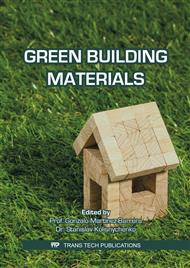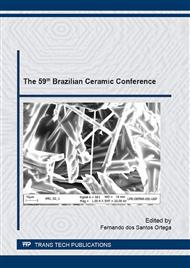p.341
p.346
p.351
p.357
p.362
p.367
p.373
p.379
p.383
Incorporation of Paint Waste from Furniture Painting Booth into Covering Mortar
Abstract:
Aligned with the world’s tendency of searching for sustainable technologies, the waste addition into materials of the civil construction is an interesting option for wastes that do not have proper destination. This work has the objective of studying the feasibility of incorporating paint waste from furniture painting booth, which currently does not have any correct ecological destination, into covering mortars and investigate if this addition brings any improvement in performance. For this purpose, it was prepared six compositions of covering mortars, with a cement-sand volume proportion of 1:6 and a Flow-table consistency of 260 mm +- 10mm, varying the waste percentage added among the proportions of 0%, 2%, 4%, 6%, 8% and 10% on the cement weight. It was determined, for each composition, the specific gravity and the air-entrained content in the fresh stage. For physical tests, it was moulded nine prismatic samples and one mortar substrate for the bond tensile strength test per mortar composition. It was determined the flexural and compressive strength in the hardened stage, the specific gravity, the water absorption coefficient due to capillary action and the bond tensile strength. Leaching tests were performed for environmental analysis of the mortars produced with waste addition. It was observed that all the mortars with waste received a similar classification to the mortar without waste, according to NBR 13281 [], and the leaching tests showed that mortars with waste were not ecologically dangerous, demonstrating the feasibility of the incorporation. In addition, mortars produced with waste presented an increase in the entrained air percentage, which might be a beneficial action of the paint waste.
Info:
Periodical:
Pages:
362-366
Citation:
Online since:
November 2016
Keywords:
Price:
Сopyright:
© 2017 Trans Tech Publications Ltd. All Rights Reserved
Share:
Citation:



